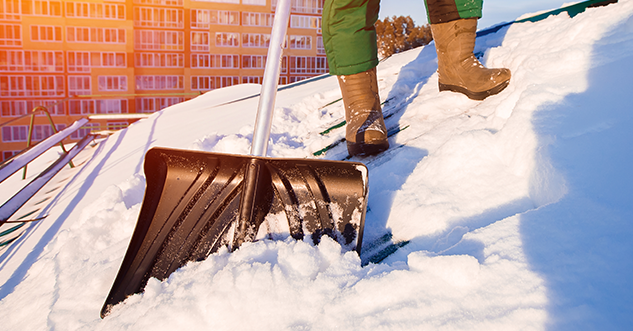The adverse effects of snow causes many concerns for building owners during inclement weather. Worker safety is of utmost importance both during shoring operation and during snow removal. If a roof is in danger of collapsing, the building should be evacuated immediately, and the following emergency procedures are recommended:
- In many situations, the most effective solution is shoring of the purlins. In most large cities, commercial shoring services are available. If not, timbers may be used.
- In some cases, removing snow build-up may be sufficient. Read to the end of this post for detailed tips on snow removal.
- Large industrial heaters inside the building may also assist in melting snow and ice from the roof.
In Case of Collapse
If a roof collapses, your first priorities are loss mitigation and prompt snow removal. Once the snow is removed, you must construct a temporary cover for weather protection and begin the cleanup. Don’t forget to document the snow loads and resulting damage.
Documenting Snow Loads and Weather Damage
Here are our top eight tips for documenting damage:
- Most importantly, you must get to the site as quickly as possible to perform a full investigation. A Varco Pruden builder and representative will accompany you.
- Building owners, the builder, and a Varco Pruden representative can make arrangements to all be on the site. One or two laborers from the builder’s crew are very helpful.
- Items to bring: a good camera, 50’ tape measure, shovels, a yardstick (with numbers legible enough to be photographed), a scale, and a container suitable for weighting snow.
- Photograph the building from as many sides as possible; general interior views; detailed photos of individual members which might indicate the nature of failure; damages to contents or lack of damages; multiple photographs of the snow, both on the building and surrounding areas, including any drifts and snow sampling procedure.
- Include notes with photos to describe the parts and their location. Sketch a building plan showing failure area, collapsed position of main members, etc.
- Obtain representative samples of undisturbed snow on the roof. Take samples as close to the collapse area as safely possible. Samples from other areas of the roof should also be taken. If the roof is inaccessible, take samples on the ground reasonably close to the building. Use the yardstick and carefully measure a 1 ft. x 1 ft. area and the snow depth. Weigh this block of snow by using the scale and container (do not forget to subtract the weight of the container). Photograph samples and weighing procedures. This procedure must be repeated at several locations on the roof, if possible.
- Make a building plan sketch showing the snow distribution and where the weight sample or samples were taken. Identify snowdrift locations and indicate any adjacent roofs or walls that would or did cause dumping or drifting conditions.
- Be sure to note snow depth on the roofs of buildings in both the general area and on the ground in the area of the building.
Have a project needing attention? Learn more about our Re-Roof options or find a VP Builder today.
